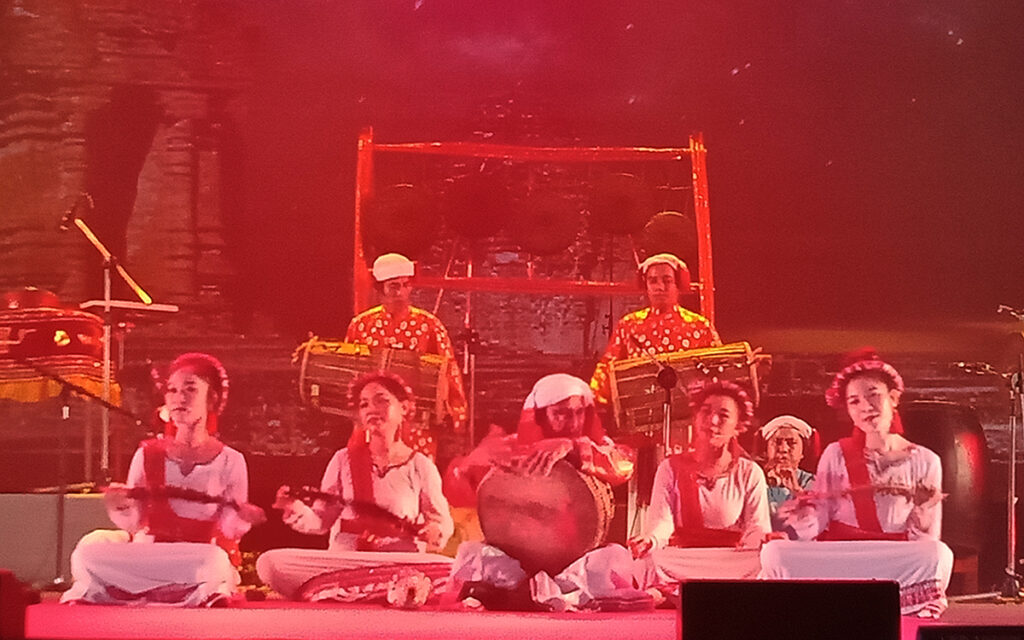ចម្ប៉ា ជាប្រទេសមួយដែលគេបានបំភ្លេចចោល។ ពីសតវត្សទី១ដល់ទី២ សមុទ្រចិនខាងត្បូងមានឈ្មោះដើមថា សមុទ្រចម្ប៉ា យកឈ្មោះតាមនាវិកក្លាហាន ដែលមានទំនាក់ទំនងពាណិជ្ជកម្មជាមួយប្រទេសជាច្រើននៅទ្វីបអាស៊ី។ តាមភស្តុតាងបុរាណវិទ្យា យើងអាចធ្វើការសន្និដ្ឋានថានាវិកទាំងនេះ មកពីកោះនៃឥណ្ឌូនេស៊ី។ គ្រឿងអលង្ការដែលបានរកឃើញក្នុងផ្នូរ បង្ហាញថានាវាពាណិជ្ជកម្មរបស់គេបានធ្វើដំណើររហូតទៅដល់ច្រាំងនៃបញ្ចឹមបូព៌ា។ កំទេចសេសសល់នៃការតាំងទីលំនៅរបស់ជនជាតិចាម ដែលមានកាលបរិច្ឆេទក្នុងសតវត្សទី២ ត្រូវបានគេឃើញនៅតាមច្រាំងនៃទន្លេធំៗនៅអាស៊ីអាគ្នេយ៍ ដែលតាមរយៈទីតាំងនោះហើយ ដែលពួកគេដឹកជញ្ជូនទំនិញពីកំពង់ផែសមុទ្រ។ នៅក្នុងតំបន់ដែលមានកោះរាប់ពាន់ចន្លោះប្រទេសអូស្រ្តាលីនិងជប៉ុន ចាមជាមហាអំណាចដែលមានឥទ្ធិពលខ្លាំងបំផុតដោយគ្រប់គ្រងផ្លូវពាណិជ្ជកម្មដោយកងនាវាដ៏ខ្លាំងក្លារបស់ខ្លួន។
ពីសតវត្សទី២ប្រជាជនចាមចាប់ផ្តើមតាំងទីលំនៅនៅតាមឆ្នេរ នៃប្រទេសវៀតណាម ហើយទាញយកអំណាចនយោបាយពីអ្នកម្ចាស់ស្រុកបន្តិចម្តងៗ។ មិនយូរប៉ុន្មានពួកគេបានបាត់បង់ទំនាក់ទំនងជាមួយមាតុភូមិរបស់ពួកគេ គឺកោះឥណ្ឌូនេស៊ី។ ជនជាតិចាមបានប្រើប្រាស់អំណាចនាវាដ៏ខ្លាំងក្លារបស់ខ្លួន ក្នុងការកសាងនគរចម្ប៉ានៅកណ្តាលប្រទេសវៀតណាម។ នៅចំណុចកំពូលនៃអំណាចរបស់ចាម ចម្ប៉ាជាមហាអំណាចដ៏សំខាន់មួយក្នុងអាស៊ីអាគ្នេយ៍ ក្នុងអំឡុងពេលជាង ១,០០០ឆ្នាំ ចន្លោះ គ.ស. ៥០០ ដល់ ១៥០០។
ប្រាសាទចាមដែលត្រូវបានគេស្គាល់ជាងគេនោះ គឺប្រាសាទមីសុន ដែលមានទីតាំងមិនឆ្ងាយប៉ុន្មានពីខេត្តដាណាង និងទីក្រុងហូយអាននៃខេត្តខ្វាងណាំ នៅប្រទេសវៀតណាមកណ្តាល។
នគរចម្ប៉ាចាប់ផ្តើមដួលរលំនៅឆ្នាំ១៤៧១ បន្ទាប់ពីការវាយប្រហារដោយរាជវង្សឡឺ ដែលគ្រប់គ្រងនៅភាគខាងជើងវៀតណាម។ ការឈ្លានពាននេះ បានធ្វើឱ្យនគរចម្ប៉ាបាក់បែក។ នៅឆ្នាំ១៨៣២ អធិរាជ មិញ ម៉ាង នៃរាជវង្សង្វៀន បានដាក់សម្ព័ន្ធមហារដ្ឋចាមចុងក្រោយ។ នេះបានធ្វើឱ្យនគរចម្ប៉ាឈានមកដល់ចំណុចបញ្ចប់ ដែលនគរមួយនេះធ្លាប់ជានគរដែលគ្រងអំណាចនៅសមុទ្រចិនខាងត្បូង។ ជនជាតិចាមមួយចំនួន ជាពិសេសអ្នកកាន់សាសនាឥស្លាម បានធ្វើចំណាកស្រុកទៅប្រទេសម៉ាឡេស៊ី និង ឥណ្ឌូនេស៊ី។ ជនជាតិចាមជាច្រើនទៀត គឺរស់នៅតាមដងច្រាំងនៃទន្លេមេគង្គ ដែលក្នុងនោះគឺមានប្រជាជនជាច្រើនដែលរស់នៅក្នុងប្រទេសកម្ពុជា។ ជនជាតិចាមខ្លះ បានរស់នៅប្រទេសកម្ពុជា តាំងពីពេលដែលនគរចម្ប៉ាឈ្លានពានអង្គរម្ល៉េះ។
ប្រវត្តិសាស្រ្តហាក់បានបង្ហាញថា នគរចម្ប៉ាកកើតឡើងដោយមិនមានប្រភពប្រាកដ ហើយរលាយទៅវិញ ដូចជានគរនេះពុំធ្លាប់មានវត្តមានមកពីមុនដែរ។ ជនជាតិចាមនិងនគរចម្ប៉ា បានបន្សល់ទុកនូវសម្បត្តិវប្បធម៌សម្បូណ៌បែប ដែលក្នុងនោះមានវត្ថុបុរាណ ប្រាសាទ និងវិមានដែលមាននៅក្នុងប្រទេសវៀតណាម។
នៅប្រទេសកម្ពុជា មានបណ្តុំនៃសហគមន៍ជនជាតិចាម ជាពិសេសនៅជាយក្រុងនៃរាជធានីភ្នំពេញ និងក្នុងខេត្តកណ្តាល កំពង់ស្ពឺ ពោធិ៍សាត់ កំពង់ធំ កំពង់ឆ្នាំង និងកំពង់ចាម។
អត្ថបទនេះ ផ្តោតទៅលើវប្បធម៌តន្រ្តីចាម ដែលខ្ញុំបានសង្កេតឃើញផ្ទាល់នៅក្នុងមហោស្រពតន្រ្តីអាស៊ាន ដែលបានប្រារព្ធឡើងពីថ្ងៃទី១៩ដល់២៤ ខែធ្នូ ឆ្នាំ២០២២ នៅទីក្រុងហូយអាន ខេត្តខ្វាងណាំ នៃសាធារណរដ្ឋសង្គមនិយមវៀតណាម។ មហោស្រពនេះមានការចូលរួមដោយក្រុមតន្រ្តីនិងរបាំអាជីព១០ក្រុមពីប្រទេសវៀតណាម និងក្រុមតន្រ្តីនិងរបាំអន្តរជាតិ៤ មកពីបណ្តាប្រទេសសមាជិកអាស៊ាន ក្នុងនោះមាន កម្ពុជា ឡាវ ម៉ាឡេស៊ី និងមីយ៉ាន់ម៉ា។

ក្រុមតន្រ្តីនិងរបាំចាម និងសហគមន៍ចាម បានប្រកាន់ជាប់នូវការរក្សាវប្បធម៌ និងប្រពៃណីរបស់គេ ទោះបីជាចម្ប៉ា គឺនគរចាមដើមនោះ សព្វថ្ងៃជាផ្នែកមួយនៃប្រទេសវៀតណាមរាប់សតវត្សមកហើយក្តី។
គួរឱ្យចាប់អារម្មណ៍ជាពិសេសនោះ គឺភាពប្រហាក់ប្រហែលគ្នានៃវប្បធម៌រវាងខ្មែរនិងចាមដែលអត្ថបទនេះកំពុងធ្វើការបង្ហាញ។ នៅកម្ពុជា លោក ពេជ្រ ទុំក្រវ៉ិល បានលើកឡើងថា ល្ខោនយីកេខ្មែរមានឫសគល់នៅក្នុងពិធីសាសនារបស់ចាម។ ក្នុងល្ខោននោះ មានការប្រើប្រាស់ឧបករណ៍តន្រ្តីចាម រួមទាំងស្គរយីកេ។ ក្រុមតន្រ្តីនិងរបាំចាម ដែលចូលរួមក្នុងមហោស្រពខាងលើនេះ បានបង្ហាញ គួរឱ្យកោតសរសើរ នូវឧបករណ៍តន្រ្តីប្រកបដោយសព្វដ្ឋភាពដែលមានឧបករណ៍តន្រ្តីវៀតណាម ពិណបន្ទះវែង និងឧបករណ៍តន្រី្តសម័យបច្ចឹមប្រទេសមួយចំនួនដែលក្នុងនោះមាន ហ្គីតារសូឡូ ហ្គីតារបាស់ អ៊រក ព្រមទាំងស្គរខ្យងស័ង្ខ ខ្លុយឫស្សី ទ្រខ្សែពីរ ស្គរមុខពីរ ស្គរភ្លោះ ស្គរធំ ឧបករណ៍ក្រឡុកមានគ្រាប់នៅខាងក្នុង និងស្គរយីកេដែលដូចគ្នានឹងឧបករណ៍តន្ត្រីដែលខ្មែរយើងប្រើប្រាស់សព្វថ្ងៃនៅកកម្ពុជា៕

———————————-
SHARING MUSICAL CULTURE BETWEEN KHMER AND CHAM
Champa has often been referred to as the “forgotten kingdom.” From the 1st to 2nd century A.D., the South China Sea was known as the Champa Sea after the brave sailors, who had trades with many Asian countries. Archeological findings attest to these sailors coming from the Indonesian islands. Archeological pieces found in their graves suggest that they reached as far as the shores of the Middle East. The settlement ruins of the Chams, dating back to the B.C. 2nd century, have been found on the river banks of South East Asia. In this thousand-island region between Australia and Japan, the Chams were perhaps the most dominant forces, controlling the trade routes with their mighty fleets.
From the 2nd century A.D., the Chams began their settlement along the coasts of Vietnam, gradually capturing the power from the locals. The Cham people then established the Kingdom of Champa in central Vietnam, which remained a significant power in South East Asia for over 1,000 years, between 500 and 1,500 A.D.
Following the assault of the Lê dynasty, ruling northern Vietnam, the Kingdom of Champa began to crumble in 1471. Finally, in 1832, the last Cham principality was annexed by Emperor Minh Mang of the Nguyễn dynasty. There came an end to the once-dominant Kingdom of Champa. Some Chams, primarily Muslim, moved to Malaysia and Indonesia. Many others still live on the Mekong River banks, including their largest population settling in Cambodia.
History reveals that the Kingdom of Champa appeared out of nowhere and disappeared as if it had never been here. It left behind a rich cultural heritage, including thousands of relics, temples, and monuments across Vietnam and Cambodia. Yet, many who traveled in the region heard very little, if anything, about this kingdom.
The rise and fall of the Cham and Champa in world history are fascinating and pathetic. In Cambodia, the Chams are considered Muslims. There are small pockets of Cham communities across the country, particularly, concentrating in the suburb-proximity of the capital city of Phnom Penh and in the provinces of Kandal, Kampong Spoeu, Pursat, Kampong Thom, Kampong Chhnaing, and Kampong Cham.
This article focuses on the Cham musical culture observed at the recent SEAN Music Festival held from December 19-24, 2022 in Hoi An city, Quang Nam province, Socialist Republic of Viet Nam. The Festival was participated by 10 professional music and dance troupes from Viet Nam and four international music and dance troupes from the ASEAN member states, namely, Cambodia, Laos, Malaysia, and Myanmar.
Cham music and dance troupes and the Cham community, for that matter, have fervently kept their culture and tradition in tact despite the fact that Champa, the original Cham Kingdom, has been part of Viet Nam for centuries.
Particularly interesting is the sharing of culture between the Khmer and the Cham as this article seeks to present. In Cambodia, Pich Tum Kravel asserted that the Khmer yike theater had its roots in the Cham ceremonies (2003: 144). Cham musical instruments are used in this theater, particularly the yike drums.
The Cham music and dance troupe participating in the above festival impressively presented ubiquitous musical instruments, including a Vietnamese dan tranh, (long board zither), as well as several Western popular musical instruments—lead guitar, bass guitar, keyboards, and a drum set—conch shell, bamboo flute, two-stringed fiddle, cylindrical drums, twin drums, large barrel drum, rattles, shakers, and the framed drums similar to and shared by the Khmer in their current repertoire and music-making.
អត្ថបដោយ៖ បណ្ឌិត សំ សំអាង






